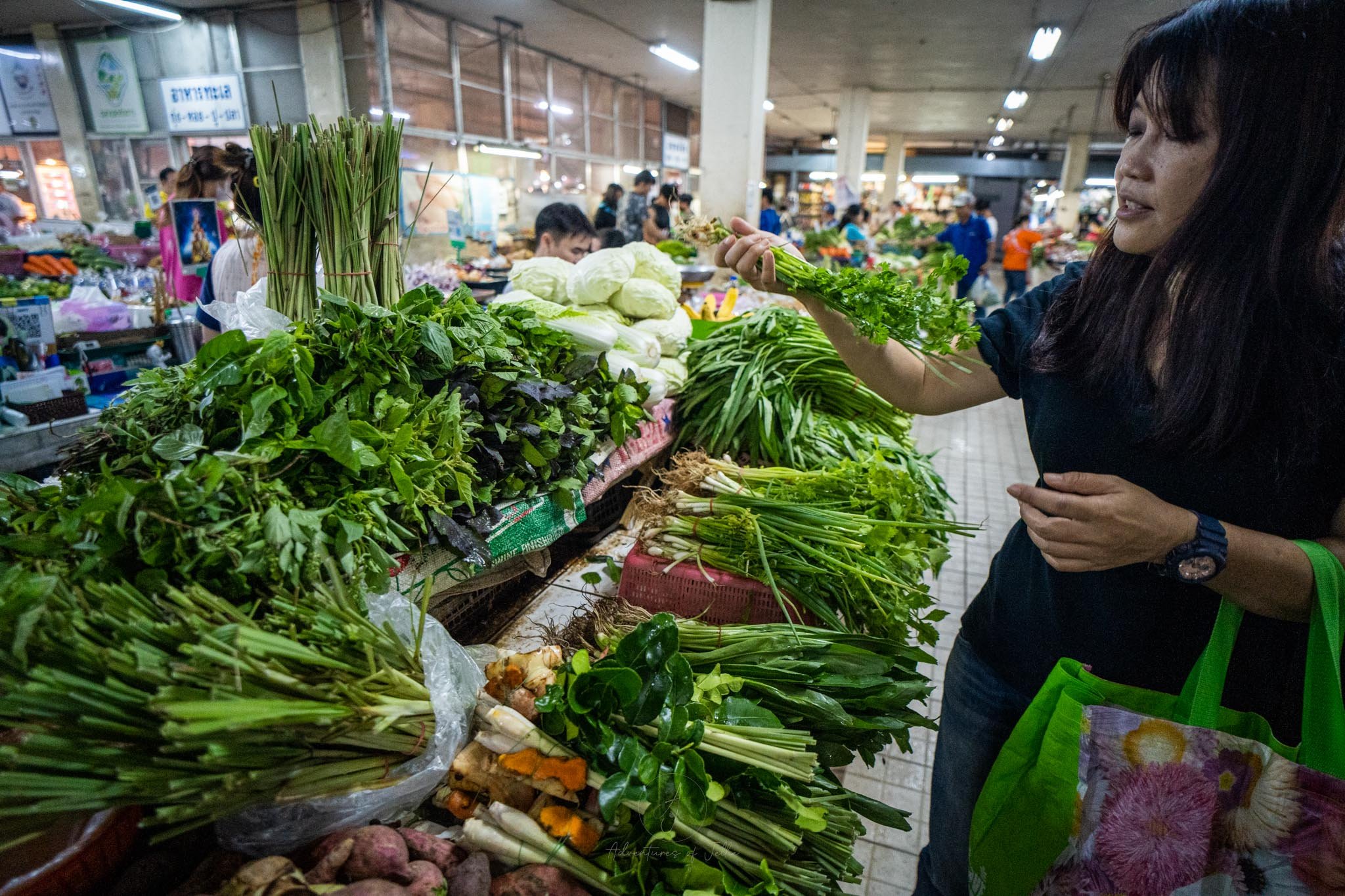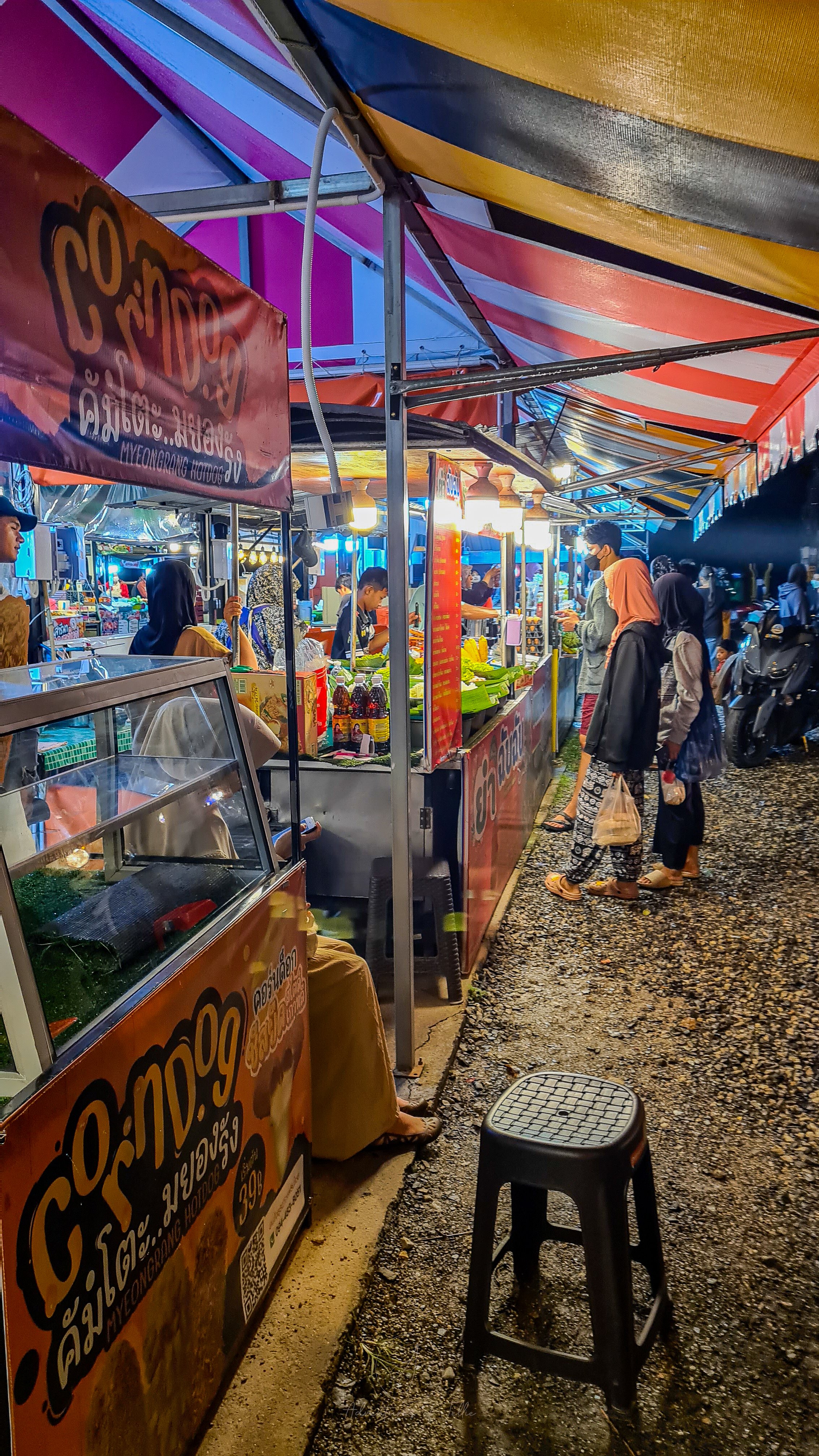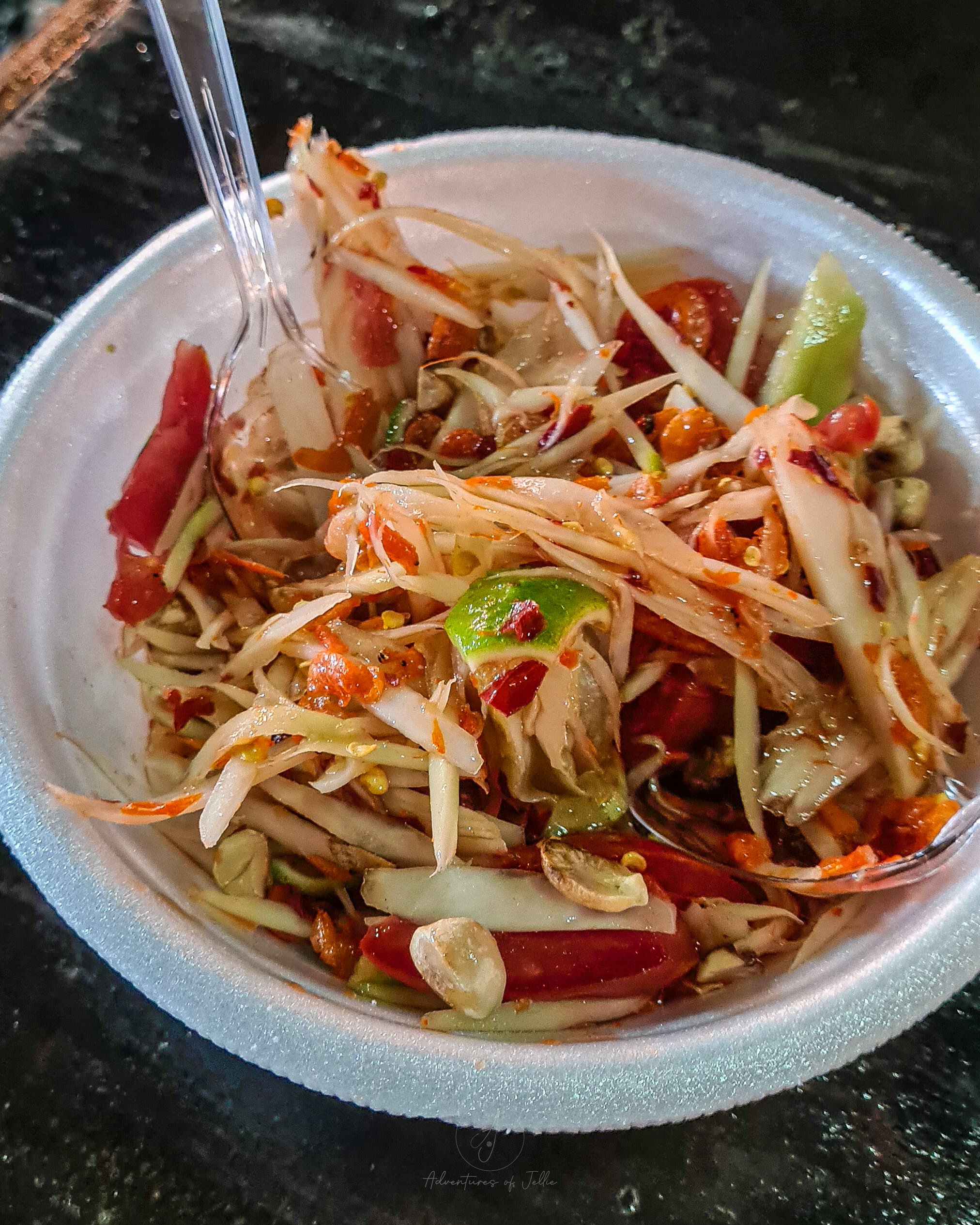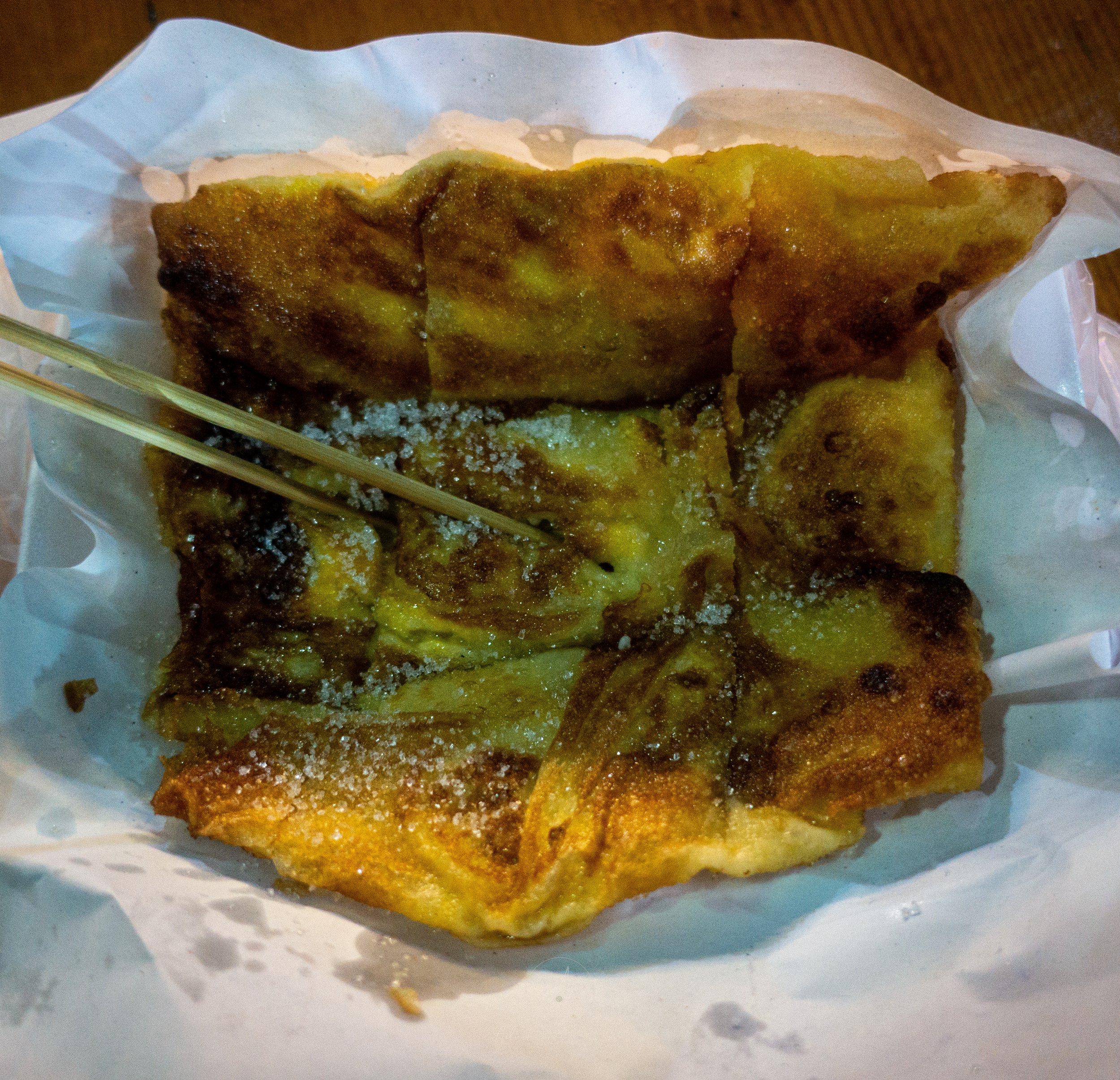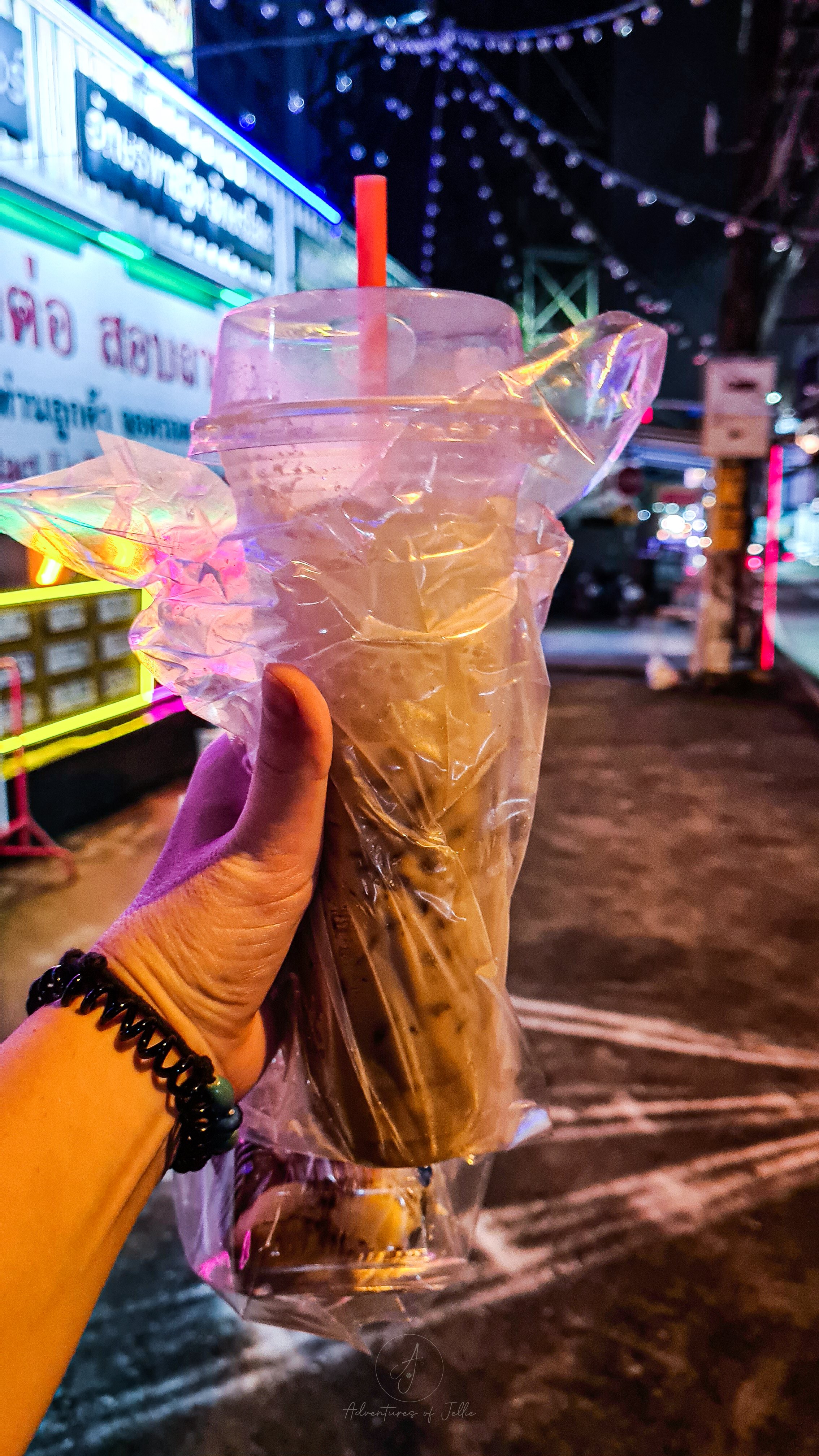The Best Northern Thai Food Tour - A Chef’s Tour Chiang Mai
Chiang Mai is a beautiful city full of unique Northern Thai cuisine. Follow us as we embark on a food tour sampling all the best dishes Thailands second city can offer! From the famous “Cowboy Hat” lady’s pork leg on rice, raw buffalo laab and northern sausages to the delicious Shan Burmese noodles outside the city walls, we eat our way to the heart of Northern Thai cooking with A Chef’s Tour!
Disclosure: This article may contain affiliate links. We will earn a small commission from any purchases made through these links.
We love Thailand. We also love our food. Put the two together, and you have some very happy Jellie!
Happy Ellie eating in Thailand!
Thai cuisine is renowned world over, for its incredible blend of hot, sweet, salt and sour flavours, but outside of Pad Thai and green curries, most people's experience of this amazingly varied cuisine falls short. We have already eaten our way through the south of Thailand, up through the islands, mainland and the chaotic streets of Bangkok, but it was now time to sample the wonders of Northern Thai cooking.
What Is Northern Thai Cuisine?
This is far too bigger question to answer! If we had to narrow it down a bit, this is what we’d say:
Northern Thai cuisine differs from its central and southern counterparts. The food in the north is heavily influenced by its Burmese, Chinese and Laotian neighbours. The northern Thai dishes blend their own cuisine with the borrowed flavours to create something deliciously unique.
Northern Thai cooking is unique in its uses of herbs and spices, sourced from the local fauna or further abroad from neighbouring countries. Due to its geographical location, river fish are more common, and jungle ingredients take a more central role. Northern dishes tend to be less creamy, with a more prominent bitter flavour.
What Is The Best Way To Try Northern Thai Food?
The best way to try Northern Thai food as always, is just to get out and eat. In Thailand, street food is king and is available 24/7, 365 days a year. Getting out amongst the street life, pulling up a chair at a plastic table and ordering whatever the person sitting next to you is eating is one of the best ways of expanding your horizon and encountering yummy food.
However, sometimes a more curated approach is necessary.
Chiang Mai is Thailand’s second city, and the true hub of the north. Chiang Mai has everything you could want to experience of northern Thai cooking. From the Old City to Chinatown, Little Burma and Shan cuisine it has a little bit of everything.
The city of Chiang Mai is big, too big to explore on foot and certainly too big to try every tasty thing it has to offer. A food tour is a great way to overcome these issues. An expert guide can show you around and lead you to the places and dishes you would never find by yourself. This is where ‘A Chef’s Tour’ comes in.
We had an amazing experience with A Chef’s Tour eating our way through southern Thai cuisine in Phuket, as well as experiencing the street food in the colourful warren of Chandni Chowk in India’s Old Delhi . Both tours were incredible, with brilliant guides who opened our eyes to the cuisine and culture and added so much context to every dish we tried. With this in mind, it was a no brainer, A Chef’s Tour was our number one choice for a food tour in Chiang Mai.
Northern Flavours - A Chef’s Tour Chiang Mai
Stop One - The Cowboy Hat Lady and Her Pork Leg On Rice
It started, as many great things do in a market. Chiang Mai’s North Gate food market is famous for its street food offerings. After dark the area outside of the Old City walls comes alive in fluorescent lights and flashing woks.
We were here to see a local legend - The Cowboy Hat Lady. She was (according to rumour) already the most popular seller of Thai style pork leg and rice when, in order to protect her eyes from the bright lamps of her stall, she started to wear her iconic cowboy hat. Her fame grew in the West when the acerbic and brilliant late Anthony Bourdain ate at her stall and featured her in his books and TV shows.
Our guide said this was technically a bonus stop as pork leg is not a uniquely northern Thai dish. Pork leg and rice traces its roots from central Thailand and the Chinese communities who brought both pigs and Chinese five spice from their homelands. We were presented with small sample plates from the smiling be-hatted proprietor.
It was beyond delicious, and the Cowboy Hat Lady thoroughly deserves her popularity. We have never eaten such tender pork! Meltingly soft seven hour stewed pork in a rich five spice sauce with a soft yolked duck egg, pickled mustard greens and a chilli vinegar. We wished our plates were larger, at least until we were reminded we had between ten and fifteen dishes still to go…
Piling into the back of the red songthaew, it was time for our next stop.
Stop Two - Roasted Meat Perfection - Clay Jar Roasted Pork and Chicken
Our next stop was a roadside wonder. Huge clay jars engraved with Chinese dragons lined the shop front. Moui, our guide (more on her later), lifted the lid on one of the jars and revealed its treasure. Huge slabs of pork belly, hung from the inside rim over flaming charcoal. The smell was amazing as the pork fat became crackling before our very eyes. The next pot was hung with roasting chickens. Again, the smell was incredible.
We quickly grabbed a table and were presented with a plate of pork, chicken and two dipping sauces.
Since coming to Thailand we’ve become slightly addicted to crispy pork belly. This was possibly the best we’ve had so far. The first layer was the crispiest crackling we’ve ever crunched, with each subsequent layer of the belly, either meltingly soft fat or perfectly tender meat. It was divine! Moui directed us to try the next bite with the dip of the special sauce. Made from soy sauce, chilli, lime and coriander root, this fresh acidic sauce cut through the rich pork belly beautifully.
The roast chicken was next. Being from England we love our roast chicken, but this was a long way from stuffing and gravy. The chicken had been marinated prior to its spell in the charcoal fired kilns, and the skin was sweet and crisp, whilst the meat was so juicy, you could eat it with a spoon. The chicken, paired with a sweeter tamarind based sauce, was again insanely delicious.
Moui explained that this location was relatively new. The stall had always been popular, and had even been featured on the popular YouTuber Mark Wiens’ channel but had exploded in popularity during the pandemic as it offered home delivery of its roasted treats. Vowing to return, it was onwards to the next stop.
Stop Three - Deep Into The North - Buffalo Bile Laab, Burmese Curry and Fermented Pork Naem
We think it's probably time we introduced you to Moui. Our tour guide had been amazing, sat in the back of our songthaew, Moui ran us through the histories of northern Thai cooking. We never knew that prior to the Chinese influence, there was no pork, no noodles and no duck in Thai cuisine. As we made our way to our third stop, she reached into her Mary Poppins bag and brought out two spice mixes.
The first of her spice boxes was full to the brim with mak waen peppercorns. We have never heard of, seen, or tasted these little peppercorns. They smelled wonderfully floral, but when eaten were like baby szechuan peppercorns. Mak waen are fundamental in the blend of spices needed for laab, our next dish. Moui’s second spice box was a treasure trove of wonderful smells. Cinnamon mixed with star anise, mace, nutmeg and finally the mak waen produced an intoxicating aromatic blend. Moui was fantastic at explaining the roles, history and effects of the spices and what they would bring to the coming dishes.
Our songthaew, driven by the silent Mr Pong, pulled up next to a small restaurant on the side of a large road. Outside the restaurant, barbeques smouldered with leaf wrapped packages being grilled on top. Inside, the smell of curries permeated the air and we were ushered to our table by the smiling owner. It was time for some truly northern fare.
Laab (larb) in Thai literally means minced. A laab salad is not what we in the West would call salad. Minced meat is combined with a spice blend as well as onions, herbs, lemongrass and chilli. The meat is served either raw or cooked and is an iconic dish both of northern Thailand and neighbouring Laos.
On our table, two dishes arrived. One a blood red, raw laab and the other a steaming cooked laab. Both were made of buffalo meat, mixed with the mak waen spice blends we had just been shown. Our guide swiftly assured us that we did not have to eat the raw buffalo laab but we had already dived in. For a salad including raw meat, blood, bile and undigested intestinal juices (Moui kept referring to this as poo juice), the raw salad was surprisingly subtle. The lemongrass and spice blend, had removed any gamey flavour, and you were left with a pleasant, tartare-esque, iron rich and slightly bitter salad. It was completely unique. The cooked laab was strikingly different. The meat and blood, now had a firmer texture and the spice mix, being cooked came through stronger. The closest comparison we could think of, was that this salad tasted a bit like a Thai version of Black Pudding. This cooked laab, eaten with a ball of sticky rice, was delicious. Moui explained that this is popular drinking food and we can see why.
The second of our dishes was a Burmese pork curry. This was incredible. Moui explained that northern Thai food is defined by a more bitter flavour profile, whereas this, originating in Burma, was sweet, cinnamony and rich in spices.
Next came the sour soup. Despite its name, the sourness was not overwhelming, just the perfect counterpoint to the rich, tender stewed beef of the soup. A slice of radish added a bite of texture and a deep savoury undertone.
The final dish of this stop was delivered from the barbeque wrapped in banana leaf. As we unwrapped the banana leaf, Moui explained that this was fermented pork or Naem Mok. Naem Mok is a traditional way of preserving pork meat. The minced sausage meat is combined with pork skin, shallots, sticky rice, salt, sugar, garlic and chilli, wrapped in a leaf and left to ferment for up to 3 days. You can use the Naem Mok raw, stir fry it or grill it. We were eating our Naem Mok grilled with sticky rice. The texture was like that of a terrine, and the flavour was amazing. When you think of fermentation, you think of sour and bitter flavours, and although they were present here, they were married with the sweet richness of pork. Each mouthful was incredible but made even better when paired with a bite of raw garlic and chilli.
Our northern feast!
After our laab and fermented pork, the unspeaking Mr Pong drove us to the amazing Siri Wattana Market.
Stop Four - Siri Wattana Market / Tha-nin Market - A Thai Market Feast - Sae Oua, Khanom Buang, Khanom Tuay, Coconut Sticky Rice, Sugarcane Juice, Thai Tropical Fruits, Fried Insects and Stir Fried Malindjo Leaf with Egg
Siri Wattana and Tha-nin markets were brightly lit and full of colour, produce and people. One of the things we love about Thailand are the local wet markets. So many fruits, vegetables, meats, fish and dried goods line tight alleyways. It looks to our food obsessed brains like an Aladdin’s cave.
We had already eaten many dishes, but it was time for the grand picnic! Moui took us all around the market, which even at 7pm was full of fresh produce and bustling life.
We took a tour of the aromat vendors and had a crash course in the many types of basil used in Thailand. After the fresh produce, we were shown big vats of curry pastes, pungent fish and shrimp pastes before going through the dried spices and noodle vendors.
We then moved through the meat and fish stalls, being shown all the different cuts of meat. From the usual bacon and pork belly, to whole pig faces, intestines and gall bladders!
After the meat vendors, we made our way down to the front where a lady was grilling northern Thai sausages - Sae Oua. Fresh off the grill, the Sae Oua were herby and full of lemongrass and spiced pork. They were so moreish, and we would love a plate of these with some sticky rice and ice cold beer! Picking up a bag full, it was time to head to the dessert aisle of the market.
We knew instantly that we had arrived in dessert town. Tables of brightly coloured sweet treats surrounded us and the smell of roasted coconut filled the air. A smiling dancing man cooked us up a fresh batch of crispy Thai pancakes - Khanom Buang. On a piping hot flat plate, circular discs of pancake batter crisp up and are filled with meringue before being topped with either orange coloured roasted coconut, or yellow shavings of egg. They are sweet, delicious and highly addictive. Next time we see these, we will pick up a bag and have them with coffee!
Next door we grabbed Khanom Tuay, a small steamed pudding of coconut and pandan. Each side is flavoured either coconut or pandan and you have to eat both together to get the full effect. They are rich, creamy, slightly salty and very yummy!
Our final pudding of this stage was the coconut sticky rice cooked in bamboo.
Peeling apart the bamboo tube revealed a fat cigar of steamed coconut sticky rice studded with black beans. Although a dessert, this sticky rice was more nutty than sweet, and super satisfying, we thought it would make an excellent breakfast.
After this round of sweets, we grabbed some fresh sugar cane and lime juice from a lovely stall holder who pressed it fresh on site. Although extremely sweet, the lime juice cut through and made for a really refreshing pick me up.
Desserts done we delved back into the market to assemble a picnic. First stop was the fruit section where we grabbed a bag full of exotic looking treats. We moved on and picked up some deep fried insects before finally ordering a stir fry from a small stall at the back of the market. We made a camp on an unused market table and unpacked our goodies.
The stir fry was eggs mixed with malindjo leaf - Bai Lieng Pad Kai. The leaf is unique to the north and is deeply savoury and rich in iron. Think spinach but on steroids. Paired with the creamy egg it was lovely.
Next came the fried insects, these are not just for the dares of drunken revellers on Khao San Road, but are an important source of protein in Thailand’s past and poorer communities. The silk worms were… an acquired taste, a taste we have not yet acquired. Crunchy, yet gooey they were not our favourite. The two different types of cricket however were strangely moreish. Crunchy and salty they would make an excellent bar snack.
Moui spread out a colourful platter of snake fruit, mangosteen, rose apple and pomelo. Each fruit was completely unique and a treat to try. Honestly we wish we had this type of selection in the UK. The sweet mangosteen were great all by themselves but the pomelos were perfect when paired with some salt, chilli, and sugar dip. We had eaten snake fruit before in Indonesia and had loved their floral tart flavour, but these were more intense with an almost alcoholic taste.
Our market feast was enormous, but this was not the end of our tour. Moui gleefully informed us that we had two more stops to make.
Stop Five - Shan Cuisine - Khao Soi Ei Si Ket and Burmese Tea Leaf Salad
Our songthaew made our way down an alleyway so small that if the paint was any thicker we wouldn’t have fitted. Colourful textile shops selling silks and traditional clothing from Burma lined the alleyway, and we were dropped off outside a tiny restaurant that Moui assured was run by a true noodle master. This was a perfect example of why you need a food tour. We would never have found this place, let alone gone in, but this one shophouse restaurant is apparently responsible for supplying a good deal of the surrounding area with delicious handmade noodles. We took a table.
This was a Shan restaurant in the Shan district of Chiang Mai. Moui explained how the Shan people of Burma had, and were, moving to northern Thailand to escape the ongoing conflicts of their homeland and had brought their cuisines and culture with them.
First up came the traditional Burmese Tea Leaf Salad. We have eaten a tea leaf salad before in Phuket but this was completely different. We do not know if it was a specifically Shan version of a tea leaf salad but it was wonderful. A tea leaf salad is made up of fermented tea leaves, raw onions and vegetables and topped with chilli, coriander and peanuts. It’s a true textural treat. This one was less sour in its fermented flavour than its Phuket counterpart, but was full of nuttiness, spice and fresh herbs. It was amazing.
Then came the noodles. The Shan noodles - Khao Soi Ei Si Ket. These noodles are a wheat and egg blend, cut to long strips, with flat sides. They have an amazing texture. Firm yet springy, they allow any sauce to cling to them. We were served the noodles in a sweet, savoury nutty sauce topped with red pork. They were delicious as they were, but under Moui’s direction, we added a healthy scoop of roasted chilli oil and a big spoon of pickled mustard leaves. These two additions elevated the dish to new heights. Smokey, sweet, nutty and sharp, it had everything.
At this point we pretty much rolled back into the songthaew. Think of Violet Beauregarde from Charlie and the Chocolate Factory.
Stop Six - One Last Sweet Treat - Bualoy Khai Wan
The tour ended where it began, at the Chiang Mai North Gate Market. The market was in full force, the Cowboy Hat Lady had a long queue to serve and all the stalls were doing a roaring trade.
We had one more dish to try. This would be another famous stall, the Bualoy Khai Wan stall. Bualoy Khai Wan is a desert made up of tapioca balls (dyed green with pandan leaf) that sit in a coconut milk broth. This broth can be topped with lots of different ingredients, from sweet corn to poached eggs and any number of fruits and jellies. Ours came topped with steamed purple taro root. The taro provided a tempering flavour against the sweet coconut milk and vanilla scented tapioca balls. It was the perfect way to finish an evening of over indulgence.
Just some of the many toppings you can choose from to top your bualoy khai wan!
With our bellies full of food, and our brains loaded with information, we bid farewell to Moui and the mute Mr Pong, happy and full with our evening of eating.
Why Book ‘A Chef’s Tour’?
The knowledge and experience of the guides is incredible. The tours are more than just a ‘greatest hits’ food tour. You get the history and culture of a place, laced through with the story of the ingredients and how society shaped the food. Not only do you get to try famous dishes like “Cowboy Hat Lady” but you genuinely go off-piste finding tiny hidden gem restaurants that truly encapsulate the best of the cuisine. As we’ve said we have used in southern Thailand and in India, and they have been consistently amazing.
How To Book Your Own Tour?
If this has whetted your appetite and made you hungry to try the best of Northern Thailand’s cuisine, then why not book your own A Chef’s Tour?
A Chef’s Tour runs two tours daily in Chiang Mai. A lunchtime tour and the evening tour we took. The lunch time tour is slightly different from the evening tour as different stalls and shops are open.
A Chef’s Tour also run tours in Bangkok, with two tours running focusing on the food from Old Siam and the backstreets of Bangkok.
For those travelling in Phuket, Thailand A Chef’s Tour also runs a tour focussing on the southern flavours in Phuket’s Old Town.
To read about our experiences on other food tours we’ve taken, check out our articles on Delhi and the Phuket Old Town.
Thanks for reading,
John & Ellie x
#adventuresofjellie
If you’ve found this blog helpful, entertaining or you just fancy supporting us please click the button below!
If you’ve enjoyed reading this article, why not save the pin below?
The £5 market munching challenge - Florida Night Market in Hat Yai, Thailand
The southern Thai city of Hat Yai is full of night markets. Following inspiration from YouTube we set ourselves the food challenge - The £5 market munching feast! What Thai foods can we get for £5? Can two people really get dinner for £5 in Thailand? How much chilli can one Som Tam contain? Is Hat Yai Fried Chicken really worth the hype? Read on to find out!
When you're travelling long term (we can say that now, it's been a whole 6 months :P) you sometimes need a bit of structure to a day, a challenge or just a goal to achieve. We came up with the £5 market challenge (okay us and a few thousand YouTubers before us).
Armed with 210 baht (just under £5 sterling) we headed off to the Florida Night Market in Hat Yai - Map Link.
We wanted dinner and so far we'd unfussily eaten extremely well and for very little in Thailand's southern city of Hat Yai.
Would we be able to eat and drink a full dinner for two for under £5?
Challenge set we headed into the colourful market.
We'd come to the Florida Night Market as it was a stone's throw away from our hostel Silla House in Hat Yai. From the balcony of the hostel we could see the lit up tents and throngs of customers coming and going, and decided this would be the perfect place to attempt our first market munch challenge!
Thai Style Barbecue Skewers
First things first, our bouches needed amusing. We were led by our nostrils to a charcoal barbecue. It was time for some skewers. Marinated and grilled to perfection, we quickly devoured two chicken skewers.
20 baht down (£0.47 / $0.58) - 200 baht remaining.
Deep Fried Quail Eggs
Walking around a Thai market as an outsider you'll always find something you haven't tried before. Today we found eggs. Okay we have had eggs before… but these weren't just any eggs (no they weren't M&S eggs - a very British reference) they were deep fried quail eggs on a skewer. Dipped in soy sauce and coated in a generous sprinkling of white pepper they were delicious! We don't know what sort of deep fried dark arts were employed in their construction but the yolks were still gloriously gooey!
One skewer of quail eggs set us back 15 baht (£0.35 / $0.43) - 185 baht remaining!
Hat Yai Fried Chicken
Hat Yai is famous throughout Thailand. Its fame is not only due to its spectacular mosque, cable car or floating market; the largest city in southern Thailand is famous for its fried chicken. Throughout Thailand all the way to the very north, you can find stalls selling "Hat Yai Fried Chicken''. As KFC aficionados there was no way we were going to miss trying this legendary chicken! Wandering up to a stall, we brought two thigh pieces. The chicken came with the traditional accompaniments of rice, sweet chilli sauce and best of all, crispy fried shallots. It's really hard to quantify quite why Hat Yai fried chicken is so good, but we can happily report that it deserves its fame. The thinnest layer of crispy batter, covers almost impossibly juicy chicken. Seriously, when we pulled the chicken apart we quickly had a lake of chicken juice form at the bottom of the container! The perfect chicken, laced with the deceptively spicy sweet chilli sauce, set atop of yellow biryani rice (also can be served with sticky rice) and spiked through with crispy, crunchy onion bits. The legend was true, it was fantastic. Hat Yai fried chicken really puts the Colonel to shame!
Two thighs with accompaniments cost 45 baht (£1.06 / $1.30) - 140 baht remaining!
Som Tam (Spicy Papaya Salad)
To accompany fried chicken we needed some fresh veggies.
This came in the form of a devilishly spicy Som Tam or papaya salad. Tomatoes, papaya, baby shrimp and a lot of chilli's smashed and bruised together with lime juice, peanuts and other wonderful things make the perfect salad. The portion was big enough for this to have been a main course all on its own, but what can I say, we are greedy and have big appetites! Mouths burning from chilli but with big smiles we finished the lot.
This salad set us back 40 baht (£0.94 / $1.15).
The then totally necessary bottle of water cost us another 10 baht (£0.24 / $0.29) - 90 baht remaining!
Banana Roti
We were now entering the sweet phase of our dining extravaganza. We had just come from Malaysia and we were already missing roti.
Luckily the very first stall in the Florida Night Market was a roti stand, and a popular one at that. We took our place in the queue behind an army of Grab drivers and ordered a sweet banana roti. We knew it was going to be good as the Grab driver in front of us was picking up at least 10 rotis for whoever he was delivering for. When it was finally our turn we were not disappointed. Tissue thin, crispy roti covered a pancake layer of egg and sliced sweet banana. There's something about the texture of a well cooked roti. It has a perfect balance of crispy exterior and chewy centre. This with the cooked banana and caramelised sugar topping made for a supremely satisfying desert.
This sweet treat set us back 25 baht (£0.59 / $0.72) - 65 baht remaining.
Thai Style Ice Coffee
To aid our digestion of this delicious Thai feast we thought we'd cap it all off with a coffee. The temperature was hovering around the 30 degree mark even at night so we opted for two iced lattes. Like others we've had in Thailand, they were extremely sweet but certainly hit the spot.
Two iced coffees cost 38 baht (£0.90 / $1.10).
Caffeinated, full and under budget our £5 challenge was a success!
Total Cost of Hat Yai Night Market Dinner
193 baht (£4.55)
Thanks for reading,
John & Ellie x
#adventuresofjellie
If want to see what else we got up to in Hat Yai click here!
If you’ve found this blog helpful, entertaining or you just fancy supporting us please click the button below!
If you’ve enjoyed reading this article, why not save the pin below?

